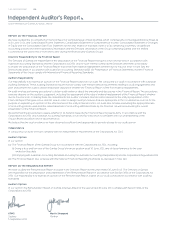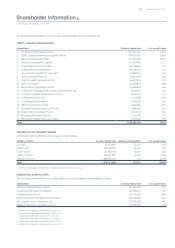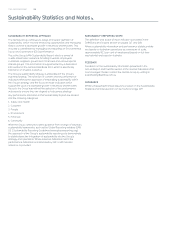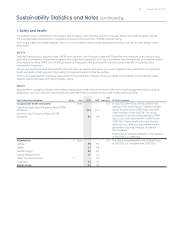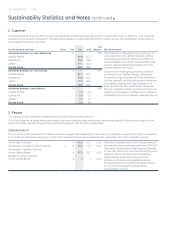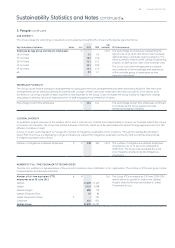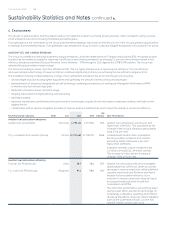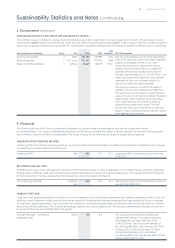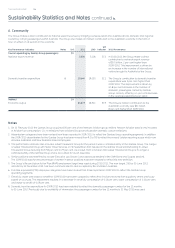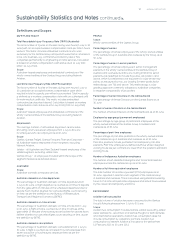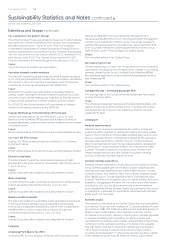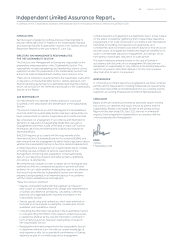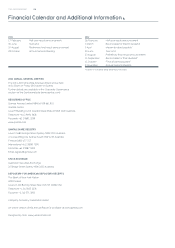Qantas 2011 Annual Report Download - page 120
Download and view the complete annual report
Please find page 120 of the 2011 Qantas annual report below. You can navigate through the pages in the report by either clicking on the pages listed below, or by using the keyword search tool below to find specific information within the annual report.
THE QANTAS GROUP 118
for the year ended 30 June 2011
CO-e emissions from aviation (Group)
The amount of greenhouse gas emissions measured in carbon dioxide
equivalent (CO-e) tonnes generated from aviation fuel consumption
(as dened above) from July to June. Under the Australian
Government’s Department of Climate Change and Energy Efciency
National Greenhouse Accounts (NGA) Factors, emissions incorporated
into the calculation include carbon dioxide (CO), methane (CH)
and nitrous oxide (NO). The Qantas Group applies the NGA
Factors conversions and methodology for the calculation of CO-e.
Scope:
As per the scope of Aviation fuel consumption.
Australian domestic carbon emissions
The amount of greenhouse gas emissions within Australia measured
in CO-e tonnes generated from aviation fuel consumption (as dened
above) from July to June that is reportable under the National
Greenhouse and Energy Reporting Act (NGER Act).
Scope:
Emissions from aviation fuel consumption by domestic ights of
Qantas, Jetstar, QantasLink, Network Aviation (included in /
only), the Group’s aircraft wetleased to Australian air Express and the
Group’s aircraft operated by Cobham Aviation Services Australia.
For / the full year aviation fuel consumption by Network
Aviation is included as required by the NGER Act.
Fuel per Revenue Tonne Kilometres (RTKs) (Group)
Aviation fuel consumption per RTKs from July to June.
Revenue tonne kilometres (RTKs) is the total number of tonnes of
paying passengers, freight and mail carried, multiplied by the number
of kilometres own.
Scope:
Wholly-owned entities of the Qantas Group excluding Network Aviation.
CO-e per RTKs (Group)
Fuel per RTKs (as dened above) converted to CO-e tonnes
by the NGA Factors.
Scope:
Wholly-owned entities of the Qantas Group excluding Network Aviation.
Electricity (Australia)
The total amount of electricity consumed as measured in MWh
(megawatt hours) where electricity is separately billed for the period
July to June.
Scope:
Qantas Group sites within Australia, excluding Network Aviation.
Water (Australia)
The total amount of water consumed as measured in kilolitres where
water is separately billed for the period July to June.
Scope:
Qantas Group sites within Australia, excluding Network Aviation.
Waste to landll (Australia)
The total solid waste and quarantine waste generated as measured
in tonnes where the Qantas Group is responsible for the waste
removal and is separately billed (that is, where there is a separately
identied item on a bill for waste and is not part of a general
overhead charge) for the period July to June.
Scope:
Qantas Group sites within Australia, excluding Network Aviation.
FINANCIAL
Underlying Prot Before Tax (PBT)
Underlying PBT is a non-statutory measure, which excludes certain
impacts of AASB : Financial Instruments: Recognition and
Measurement (AASB ) and non-recurring items that management
consider to be outside the ordinary course of business operations.
Qantas removes these items to provide more useful information that
more accurately reects the underlying performance of the Group.
Refer to Note of the Financial Report for further details.
Scope:
The controlled entities of the Qantas Group.
Net Underlying Unit Cost
The Net Underlying Unit Cost of the Group, which is the net underlying
expenditure, excluding fuel and Frequent Flyer change in accounting
estimate, divided by the Group’s Available Seat Kilometres (ASKs).
Net underlying expenditure is derived from total passenger revenue
less Underlying PBT.
Scope:
The controlled entities of the Qantas Group.
Average eet age – scheduled passenger eet
The average age of the Group’s scheduled passenger eet based
on manufacturing dates.
Scope:
The scheduled passenger eet (excluding dedicated freighters and
Network Aviation eet) of the Qantas Group, including both owned
and leased aircraft. These include Jetstar Asia eet, but exclude
Jetstar Pacic eet.
COMMUNITY
National export revenue
National export revenue is calculated as the number of inbound
visitors brought to Australia by Qantas and Jetstar (including Jetstar
Asia) for the months to May (latest available data as at June
(Source: Australian Bureau of Statistics)) multiplied by the estimated
average visitor expenditure of $,. (Source: Tourism Australia’s
March International Visitor Survey (latest available data)) (:
$, (Source: Tourism Australia’s March International Visitor
Survey)). This amount does not include the value of airfare and
freight charges that accrue to the Qantas Group from overseas
sources. These also represent export revenue.
Domestic traveller expenditure
Domestic traveller expenditure is calculated as the number of Qantas
Group domestic passengers for the nancial year multiplied by the
estimated average expenditure per visitor of $ (Source: Tourism
Australia’s March National Visitor Survey (latest available data))
(: $ (Source: Tourism Australia’s March National Visitor
Survey)). This amount includes the value of related airfares. As it is not
possible to disaggregate the data, the calculation should be viewed
as indicative only, e.g. the gure may include some international
visitor expenditure (where domestic ights are purchased after arrival
in Australia) or understate the expenditure associated with domestic
ights which are ‘round trip’.
Economic output
This measure is calculated as the Qantas Group total revenue multiplied
by a Qantas Group economic multiplier of . (as calculated by Access
Economics in ). The multiplier is derived from Australian Bureau of
Statistics input/output tables of the Australian economy. Access
Economics is an economic advisory company which provides expertise
in analysis, modelling and forecasting. Access Economics was
commissioned by Qantas to gain a better understanding of the Group’s
contribution to the Australian economy. A multiplier of . suggests
that a $ million increase in demand for Qantas’ services leads to
a $. million increase in output from all sectors in the economy,
including air transportation. In other words, the ow-on effect outside
of the Qantas Group for every $ million of revenue is $. million.
Denitions and Scopes continued
Sustainability Statistics and Notes continued


